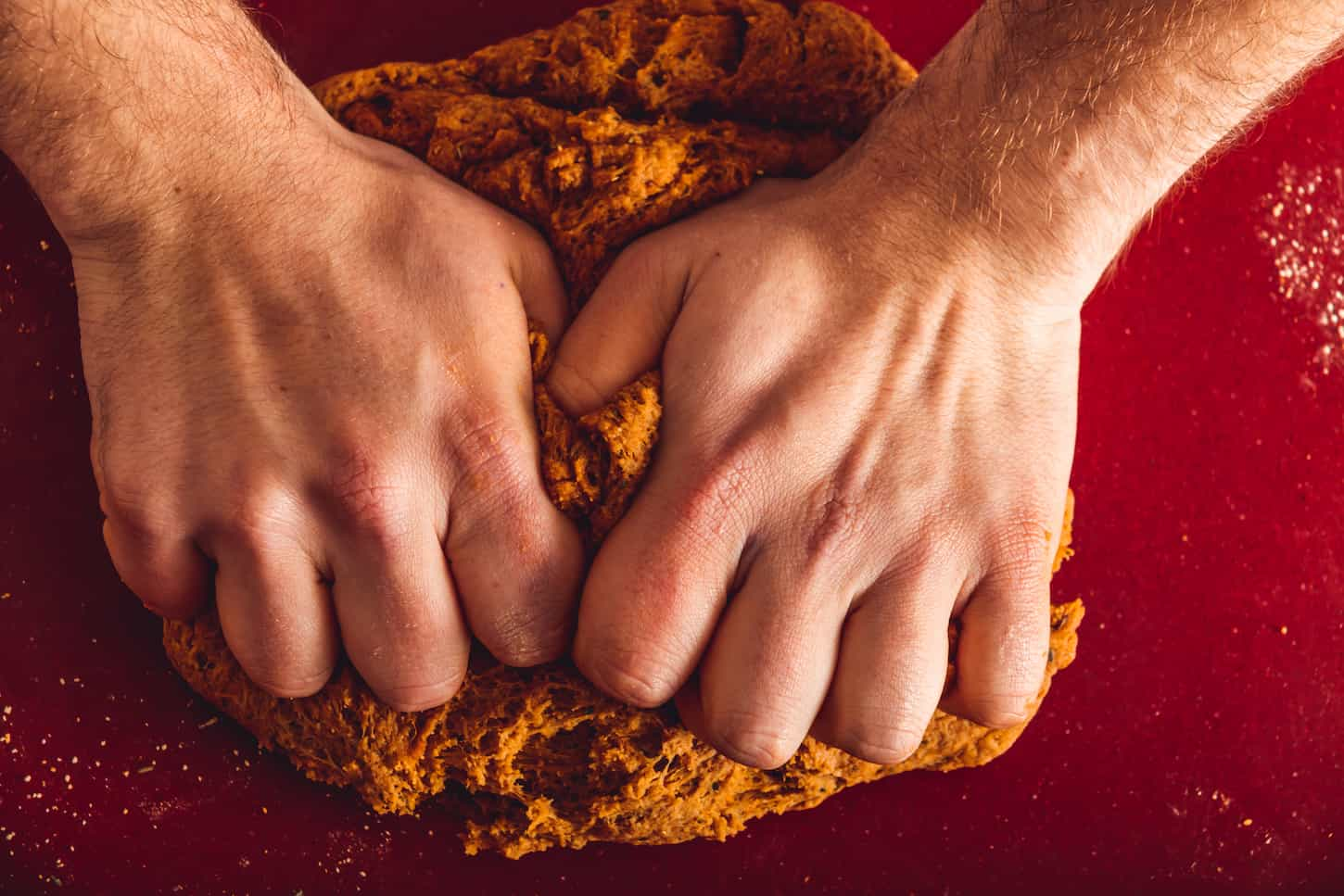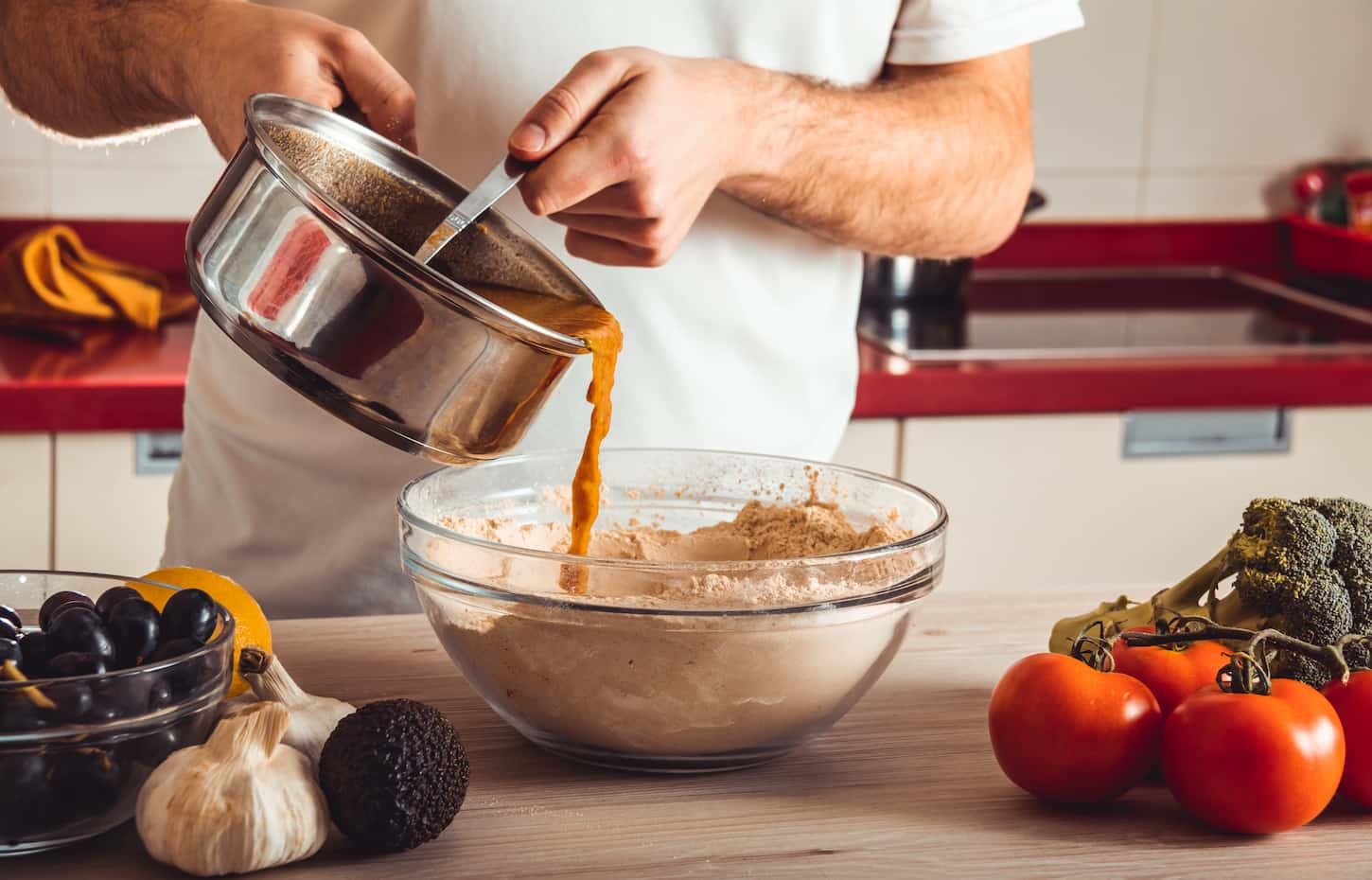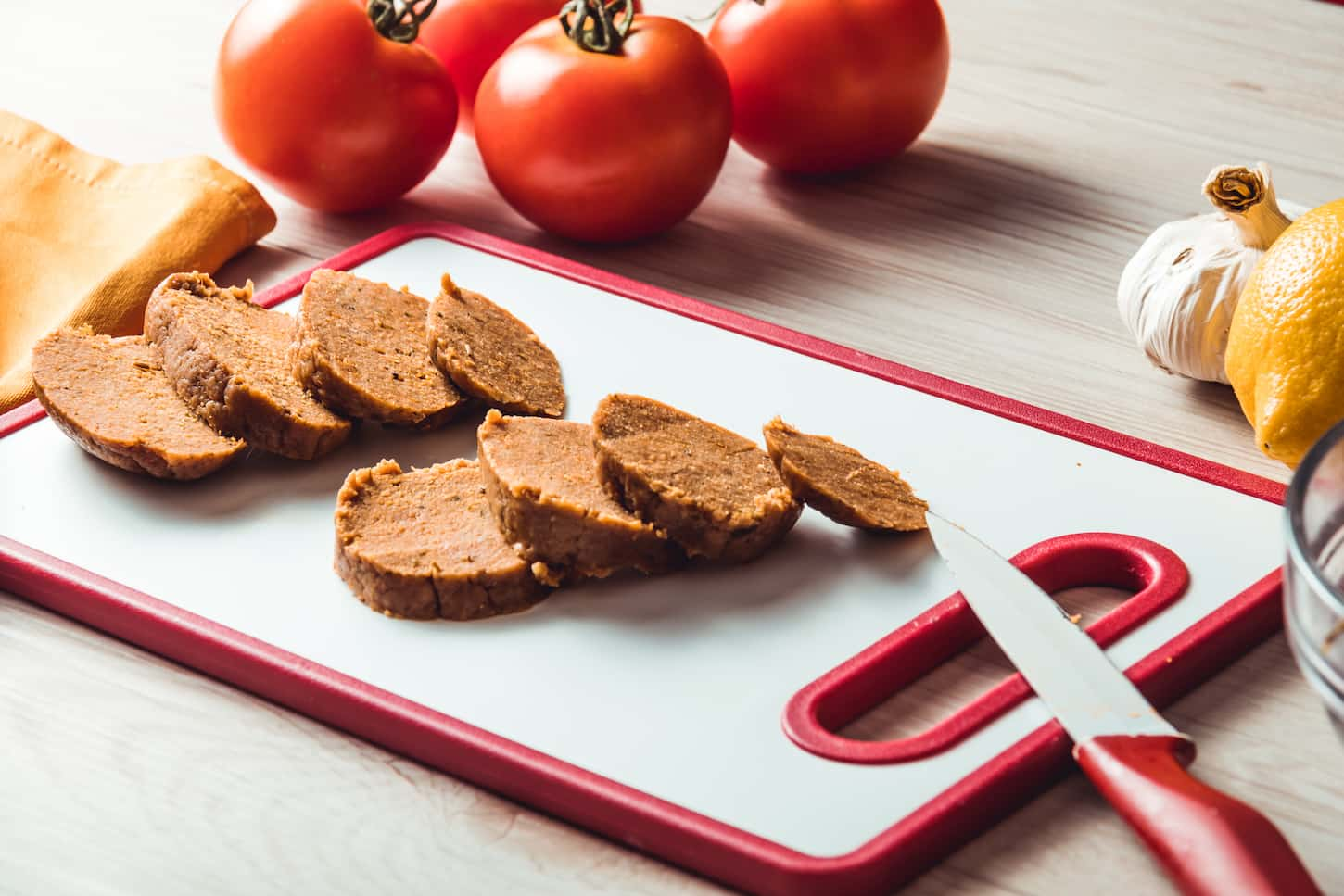Variety is one thing we all crave when it comes to our diets, regardless of our various food preferences, and seitan is one meal option that seamlessly helps with this.
Seitan, made from gluten, is also known as wheat meat or mock dock. Seitan is a mineral-rich, high protein, and low-carb alternative to animal protein, though it is quite chewy and tastes somewhat like bland chicken unless seasoned.
This popular vegan food lacks a couple of essential amino acids, so you’re going to have to combine it with other protein sources like beans, nuts, and grains to gain substantial protein from a meal.
Preparing this vegan meat substitute is super easy, all you need is a certain type of flour and water, but it’s also a bit time-consuming. You should probably steer clear of seitan if you have celiac disease or are gluten or wheat intolerant because, as I mentioned earlier, seitan is made from gluten.

How to Make Seitan (from any flour)
You can make seitan from any flour that has a high protein or gluten content of 10% and above. Wheat flours like all-purpose flour, whole wheat flour, bread flour, and white whole wheat flour are perfect for this recipe.
Here’s what you need and all you need to do to prepare this savory and nutrient-packed gluten-based meal from any of the above-mentioned flours.
Ingredients
- 900 grams of any of the above wheat flours (that’s about 6 cups)
- 2 cups of water
Instructions
- Mix the amount of wheat flour specified above with 2 cups of water then proceed to knead the dough for about 10 – 15 minutes. If the consistency of your dough is quite tough or crumbly then you should probably add a little water. If it’s sticking to your fingers then you might want to add some more flour.
- Soak your dough in cool water for at least an hour in order for the gluten strands to form then discard the water.
- Proceed to wash the starch granules out of the dough by kneading and stretching it in cool and clean water until the water becomes milky, then pour the water down the drain and repeat the process until the water is clear or cloudy.
- You’ll have yourself a coarse and ugly mass of gluten once you’re done washing, this should yield up to about 4 – 6 servings of seitan. Leave it to sit for about 20 minutes so the gluten strands can develop and have a slightly smoother appearance.
- Voila! You’re past the intensive stage and can now proceed to seasoning and cooking.
Notes
You can do the following, in place of the second instruction, if you’re trying out this recipe in warmer weather conditions; wrap your dough in a cooking sheet and leave it to rest on your counter for about 30 minutes.
How to Make Seitan with Vital Wheat Gluten
Making seitan from vital wheat gluten is much easier and faster than using wheat flour or the washing the flour method. All you need to do is knead your vital wheat gluten and season it into a soft dough, leave it to rest for a while, and then cook it.
Vital wheat gluten is basically powdered and concentrated gluten, made from wheat but stripped of most of the major components of the wheat berry, while wheat flour is mostly starch, contains lesser protein and has all the essential parts of the wheat berry.
A lot of people prefer wheat flour to vital wheat gluten when making seitan because the unpleasant ‘gluten-y’ or ‘wheaty’ taste that seitan often has is less pungent when you use the wash the flour method that comes with using wheat flour.
Here’s a detailed step-by-step guide on how to make seitan with vital wheat gluten.
Ingredients
- 1 cup of vital wheat gluten
- 1 teaspoon of salt
- 1 teaspoon of garlic powder
- 1 teaspoon of ginger powder
- 2 tablespoons of soy sauce
- 1 cup of chicken broth
Instructions
- Mix your vital wheat gluten, salt, garlic powder, and ginger powder in a bowl.
- Mix your soy sauce and broth in a separate bowl.
- Pour the contents of your first bowl into your second bowl then proceed to knead the mixture with your hand for some minutes until it’s firm and rubbery.
- Let the kneaded dough sit for some minutes and then knead it again.
- Flatten out the seitan then proceed to cut it into tiny chunks, chunks that are too large will not be sufficiently penetrated by the broth.
- You can now cook the seitan. Get your pot and empty your seitan chunks into it, add six cups of chicken broth to it then proceed to boil it for about an hour or two.
Notes
Make sure the heat isn’t too high when boiling, it should cook at a steady and low simmer. Cooking your seitan for too long would give it an unpleasant texture. Once you’re done cooking your seitan, you can eat it immediately but I recommend you let it cool for about 4 hours so the texture would be much more savory.

Can I Use White Flour to Make Seitan?
White flour is pretty much the same thing as all-purpose flour and can therefore be used to make seitan. It contains 10 – 12% of protein which should yield a substantial amount of seitan when washed.
Like I said in the beginning, wheat flours are the best for this recipe. Here’s a table of the types of wheat flour that can be used for this recipe, their protein content, and how long they can last.
| Type of Wheat Flour | Protein Content | When Stored in a Pantry | When stored in a freezer/fridge |
|---|---|---|---|
| All-purpose flour | 10 -12% | Lasts up to a year | Lasts up to a year |
| Bread flour | 12 – 16% | Lasts up to 6 months | Lasts up to 2 years |
| Whole wheat flour | 16% | Lasts up to 1 -3 months | Lasts up to 2-6 months |
| White whole wheat flour | 12 – 13% | Lasts up to 1 -3 months | Lasts up to 2-6 months |
You should also note that the protein content of the wheat flour types varies from brand to brand, so make sure you check the nutritional label of the package before buying the flour.
Here’s a simple calculation you can do to convert the protein in grams to percentage:
Protein amount in grams ÷ serving size in grams × 100 = % protein.
Is Seitan Reheatable?
You can heat up your seitan in a pan or microwave it, but make sure you reheat it with a little water or it will dry out.
Seitan is also susceptible to freezer burns and can absorb smells or odors; these factors won’t necessarily render it unsafe to eat, but they can give your seitan a funky smell and unpleasant taste over time.
If you store your seitan right, then you don’t have to worry about this happening. But if you’re a bit confused about what proper storage entails, I’ve covered that extensively in the fourth subheading after this.
Can You Bake Seitan?
There are lots of creative and delicious seitan recipes that call for you to bake it but you’re going to have to be very careful because seitan can explode in the oven. You can avoid a seitanic explosion, when trying out a recipe that requires you to bake, by wrapping the seitan properly with a sheet of heavy-duty tin foil.
If you’ve been trying to get a more solid consistency when making seitan and haven’t tried baking it, then you should try this; roll your raw mass of wheat gluten into a log, cut it up into slices then bake it for about 15 minutes in the oven.
The outcome should be exactly what you want if you’re not a fan of spongy or mildly chewy seitan.
Can You Make Seitan from Self-Rising Flour?
Self-rising flour is a mix of regular flour, baking powder, and salt and usually contains little protein, so it’s not ideal for making seitan.
You’d probably get a meager and not so chewy mass of wheat meat if you use this type of flour, also remember that the most ideal flours for this recipe are the ones with a high protein content of 10% and above. Make sure you check for this before you make your purchase.

Where Can You Buy Ready-Made Seitan?
You can buy seitan at a typical grocery store, a local health food store, a natural food store, or a large farmer’s market if you don’t have the time to make it yourself, although making it is more economical.
Finding the seitan at the store is pretty simple. If you know where the tofu is stocked, then there’s a 99% chance that the seitan packages are nearby. Some grocery stores have a natural foods section where most vegan products can be found so just ask where it’s located and look through the refrigerated areas for some seitan.
Seitan is usually at the grocery store by the tofu or other vegan products in the refridgerated section.
Stores like Wal-Mart and Target often stock the tofu and seitan at the edge of the produce section. Although seitan is usually stored in the refrigerator, you might also be able to find it in the freezers under the ‘meatless’ section. Sometimes seitan packages look a lot like Tempeh packages.
You can also order this vegan meat online if you’re having trouble finding it at your local stores.
Seitan can also be bought in bulk via local restaurant food suppliers, typically suppliers of local Asian restaurants. All you have to do is ask the restaurant for the contact details of their supplier or ask if they have seitan available for purchase.
How Can You Store Seitan? How Long Can You Store Seitan?
It’s important that you know the state that you choose to store this animal protein alternative in, determines how long it would last but generally, refrigerated seitan lasts for about a week while seitan stored in the freezer can last up to 6 months.
Seitan can be stored in three states; dry or baked, moist and raw, each state calls for different preservation tactics and different durations. Below you’ll find all you need to know about storing seitan according to the states you can store them in.
If you’re making use of store-bought seitan, make sure you make use of the expiration date provided on its packaging.
| Storage Method | How Long it Stores |
|---|---|
| Countertop | 1-2 hours, then move it to another place for longer storage |
| Fridge | 7-10 days (7 days is safer, so use that) |
| Freezer | up to 6 months |
| Freeze-dried | up to several years |
State #1: How to store baked or dry seitan
If you plan on using your seitan in dry dishes such as stir-fries then you should probably store it dry. You can successfully store your seitan dry by wrapping it in aluminum foil or cling film and placing it in the fridge. Double wrapping would help keep it from absorbing odors.
When storing your dry or baked seitan in the freezer, ensure it is double wrapped with cling film on the inside and aluminum foil on the outside, this would make it less vulnerable to freezer burns, which can make your seitan taste awful, and prevent it from absorbing the unpleasant smells. You can also go the extra mile and place the wrapped seitan in a freezer-proof bag.
Refrigerated dry seitan lasts up to 4-5 days while frozen seitan can last up to 6 months
State #2: How to store moist seitan
You might want to store your seitan moist if you’re planning on using it in wet dishes like stew, soup, or sauce.
You can achieve this by keeping the seitan in its broth. All you have to do is pour your seitan along with the broth into an airtight Tupperware container and store it in the refrigerator or freezer.
If you chose to store it in the refrigerator, your seitan should remain fresh for not more than 10 days but I suggest you don’t take chances and make use of your seitan within a week.
This storage method enhances the taste of your seitan as it keeps absorbing the flavor of your broth making it tastier when it’s cooked.
Freezing is the best way to store your seitan for more than a week, though frozen seitan might have a chewier texture. I promise it’ll still be savory and nutritious regardless.
When storing your seitan in the freezer, make sure you mark the container in a way that you can easily calculate how long it has been in there. You should also make sure the container is well filled and sealed properly.
Freezer stored seitan can last up to 6 months.
State #3: How to store raw seitan
Seitan can also be stored in its doughy or raw state. The first thing you’d have to do is cut it up in chunks so that you don’t have to break up its mass every time you want to cook with it. Then, double wrap it in cling film or aluminum foil a store it in the refrigerator or freezer.
Raw refrigerated seitan can last up to a week while raw seitan stored in the freezer can last up to 6 months.
Additionally, blast freezing or flash freezing is a great way to efficiently store your seitan in portions or chunks because defrosting your entire seitan every time you want to use a small portion of it can be wasteful or can deteriorate your seitan over time.
By blast-freezing reasonable chunks of your seitan, you can save yourself the stress of having to thaw the entire mass every time you want to make use of a portion of it, just store the chunks you flash-freeze in a Ziploc bag and keep it in a freezer once you’re done.
Frozen seitan is best thawed in the refrigerator, seitan stored in broth takes way longer to defrost than dry or baked seitan, it’s best to bring it out the night before, but if you need to thaw your seitan quickly you can defrost it under running water.
I also learned that re-boiling your seitan in broth twice every week or every 3 to 4 days can efficiently help extend its shelf life indefinitely. You can also preserve the moisture of your seitan by adding a bit of water or sauce to it while it’s cooking.

How to Get Rid of the “Gluten-y” or “Wheaty” Taste of Your Seitan?
You can mellow out the strong gluten or bread-like taste that seitan made with vital wheat gluten often has by making use of the below condiments in your recipe or by using the wash the flour method that is required when using wheat flour.
Below you’ll find a list of the four condiments that can be used to tackle the pungent wheat taste in your seitan.
Condiment #1: Baking Soda
Baking soda is an easy-to-find ingredient that efficiently tackles the pungent gluten taste of seitan made with vital wheat gluten. You don’t need to add so much to your recipe, about ¼ teaspoon per 150 grams of vital wheat gluten should be just enough.
Using baking soda and baking powder interchangeably for this recipe would not bring about the same result. Baking soda and baking powder both cause rising action in baked goods but are not the same. The first needs an acidic ingredient before it can cause rising action while the latter possesses dry acid and causes rising action once water or a wet ingredient is introduced.
If you use baking powder to mellow out the gluten taste in your seitan, you would not only get seitan with an unchanged taste, you’d get a fluffy mass of wheat meat. Also do not add an acidic ingredient when employing baking soda to your seitan recipe.
Condiment #2: Apple Cider Vinegar (ACV)
Although apple cider vinegar has a strong flavor it’s also a great condiment for mellowing the gluten-y taste of your seitan. You’d think its equally pungent flavor would negatively influence the taste of your seitan, but I promise you this is not the case.
2 tablespoons of ACV is typically enough for 500– 600 grams of vital wheat gluten, you might want to use less apple cider vinegar if you’re adding other heavily acidic ingredients or vinegar to your mix. Also please include ACV in the mix when it’s wet.
Condiment #3: Mustard
This condiment isn’t really popularly used but it still does a decent job in enhancing the taste of your seitan. You can make use of either prepared mustard or mustard seed, just have the following information in mind when making use of each condiment.
Prepared mustard contains vinegar, which is acidic, so it shouldn’t be used with baking soda. If you decide on your mustard seed, it’s much more neutral and can be used with either baking soda or apple cider vinegar.
Condiment #4: Chickpea Flour
Mixing chickpea flour and nutritional yeast into your seitan also helps tackle the unpleasant taste of gluten. I do not recommend you use freshly ground chickpea flour in your recipe, as it makes the seitan taste horrible.
Seitan Nutrition Facts
Seitan contains just about the same amount of protein contained in animal meat and it is not made from soy like most other plant-based products.
It does lack two essential amino acids (namely lysine and threonine), but this can easily be balanced out by consuming it with other vegan-friendly proteins like nuts.

Final Thoughts
There you have it, this is all you need to know about how to make seitan. Feel free to experiment with various online recipes and create various recipes of your own. We hope you found this guide helpful and easy to understand.
This recipe isn’t really exclusive, anyone looking to improve or spice up their diet can enjoy a steaming hot serving of seitan. This is basically the best part about this meal option, as it isn’t really confined to any dietary preference.
Whether you’re a pescatarian, vegan, vegetarian, or prefer an omnivorous diet, seitan can seamlessly meet your needs.
And because it’s made from flour, it’s an easy way to use up that wheat from your food storage whether there’s an emergency, a zombie apocalypse, or you forgot to get tofu for making tacos.
Now, if you’re trying to make sure you’re prepared for any of these (or other) possibilities, make sure you’re prepared with all of your favorite foods. Make sure you check out my must-have kitchen tools and food storage gizmos right here. I think a few of them will surprise you!
Resources
Learning from your own experience is essential, but learning from others is also intelligent. These are the sources used in this article and our research to be more informed as homesteaders.
- Carballido, E., & Editorial. (2019, April 22). How to preserve seitan. Botanical online. https://www.botanical-online.com/en/food/seitan-how-to-preserve.
- Starr, Kimberly C. “Seitan: How to Make This Meat Substitute From Scratch At Home.” Kimberly C. Starr, 24 June 2021, kimberlycstarr.com/cooking-food-storage-transform-wheat-meat-seitan/.
